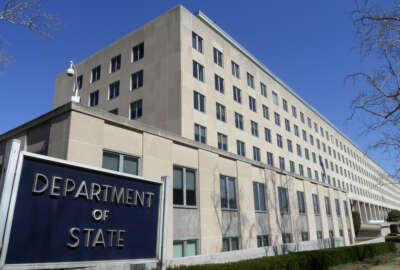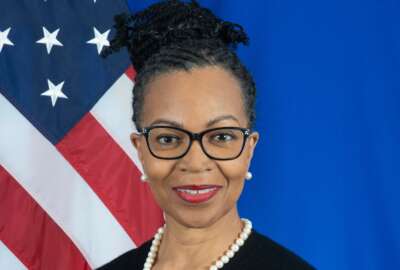

The State Department, for the first time, holds disaggregated workforce data sets that break down the composition of its workforce across nearly every one of it...
The State Department is setting five-year goals to promote diversity, equity, inclusion and accessibility across its workforce, as part of its recently released DEIA strategy — one of many such documents penned by agencies under the Biden administration.
But to track progress on those goals, the State Department, for the first time, holds disaggregated workforce data sets that break down the composition of its workforce across nearly every one of its offices.
This level of data maturity marks a major milestone for the department and its new data-focused Center for Analytics, and gives its leadership a better picture of the state of the workforce.
Chief Diversity and Inclusion Officer Ambassador Gina Abercrombie-Winstanley has made more comprehensive workforce data one of her top priorities since taking office last year.
In a Sept. 23 interview, she said the State Department’s better data snapshot of its workforce makes the goals of its DEIA strategy more achievable.
“I certainly knew before I started the job that nothing was going to make sense if we didn’t know where we are. How do you judge progress, how do you judge that you’re making improvements without that data?” Abercrombie-Winstanley said.
This improved workforce data snapshot addresses concerns from the Government Accountability Office, which found the department has significant gaps in measuring DEIA improvements.
Secretary of State Antony Blinken also highlighted the department’s workforce data advances as an important step in diversifying its ranks.
“We have, for the first time ever, a remarkable data set, where we’ve disaggregated data, and we have a picture of virtually every single office in the department, where we are, where we’re not, where we need to go,” Blinken said at a recent event where he announced the creation of two new State Department fellowship programs.
Abercrombie-Winstanley said the department pulled together workforce data scattered across many offices to bring greater transparency to its workforce’s demographics.
“Certainly, we had been very, very conservative in the past, not only with how we collected it, but how we shared it. I think you would find anyone on Capitol Hill, from any party, complaining about the lack of transparency from the Department of State with regard to the workforce,” she said.
Abercrombie-Winstanley said her office worked with Chief Data Officer Matthew Graviss and data experts from the Bureau of Global Talent Management to improve the state of the department’s workforce data.
“We brought some expertise onto my staff, and really sliced and diced and crunched the numbers. And then, with the secretary’s full support, we said, ‘OK, this is not just for us, this is for everyone,’ because this is, frankly, a whole of government effort, but certainly within our organization, that everybody needs to be able to see where we’re starting, so they can judge where we’re going, and whether we’re getting there,” she said.
More comprehensive workforce data allows the agency to drill into things like employee retention and attrition. The data shows, as GAO has documented for decades, that the department’s higher ranks are less diverse than its workforce as a whole.
“We see as people go up the ladder, it thins out,” Abercrombie-Winstanley said. “The bottom line is women and minorities do not lose brain power as we go up the ladder, so something else is going on there that suddenly the upper ranks become far more homogeneous, with regard to gender and with regard to racial background.”
Abercrombie-Winstanley said her office is conducting barrier analyses and identifying bottlenecks that prevent a more diverse pool of candidates from receiving promotions to serve in the department’s higher ranks.
“How are we advertising these positions? Where are we advertising the positions? Are we getting the right people interested? Are they following through on the application? And if not, why not?” she said.
The department, looking to eliminate one potential bottleneck, is making interview panels a best practice for hiring and promotion decisions, rather than leaving the decision up to a single individual.
“We’re not fully there yet, but we’ve made huge strides, which is not having a single decision-maker,” Abercrombie-Winstanley said.
While the department is making strides to improve the utility of its workforce data, it relies on employees to self-identify their gender and ethnicity on its surveys.
Abercrombie-Winstanley said better data relies on higher participation in those surveys, which starts with building up employees’ trust.
“The first thing we have to do is make sure that everyone understands how the data is used, and how the data is stored, and that the demographic data is not associated with an individual name,” Abercrombie-Winstanley said.
Abercrombie-Winstanley previously recalled that she didn’t fill out every survey during her Foreign Service career that would have identified her as an African American woman, “because I wasn’t sure or I didn’t think it would make a difference on what’s going to happen.”
“I knew that if I hadn’t done it, a whole lot of people haven’t done it, and so I fessed up I hadn’t done it, but I’ve done it now, and that other people need to,” she said.
Employees with disabilities, she added, are particularly hesitant to self-report their status on workforce surveys.
“People have been reluctant to identify with having a disability,” she said. “If we are spending $5 million on reasonable accommodations or making things accessible, and we’re doing that for 150 people with a disability, that’s not a bad ratio of money-to-employee. But if, in fact, we really have 1,000 people with disabilities, that isn’t enough money.”
The department is also working to expand the choices it gives employees when asking them to self-report demographic data, especially for workers who are part of the LGBTQ community.
“Some of our employees said, ‘You know, I check a box, but my box isn’t there,’” Abercrombie-Winstanley said.
The department is also working with the Census Bureau and the Centers for Disease Control and Prevention to expand workforce data to include whether employees are first-generation Americans or first-generation college graduates.
The department also expects that its upcoming Workforce Flexibilities Plan, under its Future of Work initiatives, will help advance its DEIA principles.
The department, for example, is taking steps to allow Foreign Service candidates to conduct structured interviews virtually, starting next year, without having to travel to Washington, D.C.
“Using this sort of technology to do our oral exam is expanding who has access to join us in the first place,” Abercrombie-Winstanley said. “We’re already making big changes that are having an impact on geographic diversity and socio-economic status. You don’t have to shell out that increasingly expensive airline ticket and hotel and whatever else in order to take the Foreign Service exam.”
Abercrombie-Winstanley said more flexible work options are expected to improve retention for employees with disabilities, as well as parents trying to balance child care and work.
The State Department, once a relative stranger to telework for most functions prior to the COVID-19 pandemic, is taking major steps under its future of work initiative to give employees more flexibility to get their jobs done.
Abercrombie-Winstanley described herself as an extrovert who prefers to work in the office, but said she has a “100% hybrid” office that includes two other employees.
“That flexibility actually adds to our productivity. So even though it’s not my personal inclination, and I’m old school … I think every person in the department has come to that realization one way or the other,” she said.
Copyright © 2024 Federal News Network. All rights reserved. This website is not intended for users located within the European Economic Area.
Jory Heckman is a reporter at Federal News Network covering U.S. Postal Service, IRS, big data and technology issues.
Follow @jheckmanWFED


